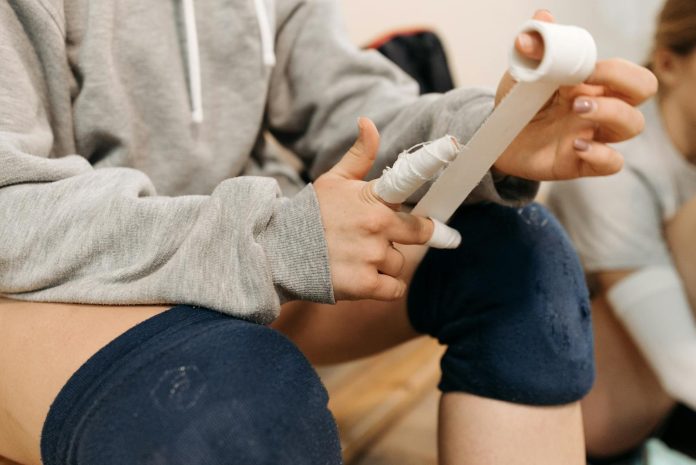Athletic tape has become a crucial tool in the world of sports and physical activity. Whether you’re a professional athlete or a weekend warrior, the chances are you’ve encountered this versatile product. In this comprehensive guide, we’ll delve into the many aspects of athletic tape, including its benefits, types, and best practices for application. This article is designed to give you all the information you need to make the most of athletic tape, whether you’re using it for injury prevention, support, or recovery.
What Is Athletic Tape?
Athletic tape is a type of adhesive tape designed specifically for use in sports and physical activities. It’s typically used to support and stabilize joints and muscles, helping to prevent injuries or manage existing ones. Athletic tape can also enhance performance by reducing muscle fatigue and providing proprioceptive feedback.
History of Athletic Tape
The use of tape in sports dates back several decades, with early forms being nothing more than simple adhesive bandages. However, as sports medicine evolved, so did the materials and techniques used in taping. Modern athletic tape is a product of years of research and innovation, offering advanced properties like elasticity, breathability, and water resistance.
Why Use Athletic Tape?
Athletic tape serves multiple purposes, making it a versatile tool in sports medicine. Here are some of the primary reasons athletes and trainers rely on it:
- Injury Prevention: By providing support to vulnerable joints and muscles, athletic tape can reduce the risk of injuries like sprains and strains.
- Injury Management: For athletes recovering from an injury, tape can help stabilize the affected area, allowing them to continue participating in activities while minimizing the risk of re-injury.
- Performance Enhancement: Certain taping techniques can improve proprioception (awareness of body position), helping athletes maintain better form and technique.
- Pain Relief: Athletic tape can reduce pain and inflammation by restricting harmful movements and providing gentle compression.
Types of Athletic Tape
There are several types of athletic tape, each with unique properties and uses. Understanding the differences between them is crucial for selecting the right tape for your needs.
Rigid Athletic Tape
Rigid athletic tape is the most common type used in sports. It’s a non-elastic tape designed to provide strong support and limit joint movement. This tape is often used in taping techniques that require high levels of stability, such as for ankle sprains or wrist injuries.
- Material: Typically made from cotton or rayon, rigid tape has a strong adhesive to ensure it stays in place during physical activity.
- Uses: Ideal for joints that need immobilization, like ankles, knees, and wrists.
- Application: Rigid tape is applied over pre-wrap or directly to the skin, depending on the sensitivity of the area.
Kinesiology Tape
Kinesiology tape is an elastic therapeutic tape that has gained popularity in recent years. Unlike rigid tape, kinesiology tape allows for a full range of motion while providing support and pain relief.
- Material: Made from cotton with an elastic polymer, kinesiology tape is designed to mimic the skin’s elasticity.
- Uses: Commonly used for muscle injuries, swelling, and providing proprioceptive feedback.
- Application: Kinesiology tape is applied with tension along the direction of the muscle fibers to support and lift the skin, reducing pressure and improving circulation.
Cohesive Tape
Cohesive tape sticks to itself but not to the skin, making it an excellent option for securing bandages or other tapes in place without the discomfort of adhesives on the skin.
- Material: Usually made from non-woven materials like polyester or latex-free rubber.
- Uses: Often used to secure padding or as a secondary layer over another type of tape.
- Application: Easy to apply and remove, cohesive tape is ideal for quick wraps and securing dressings.
Elastic Adhesive Bandage (EAB)
Elastic adhesive bandage combines the benefits of both rigid tape and kinesiology tape. It provides support while allowing for some movement, making it ideal for dynamic areas of the body.
- Material: Made from stretchable fabric with a strong adhesive.
- Uses: Suitable for areas requiring both support and flexibility, like the knee or elbow.
- Application: Applied with varying tension depending on the level of support needed, EAB can be used for both prevention and rehabilitation.
How to Apply Athletic Tape
Proper application of athletic tape is crucial to maximizing its benefits. Here’s a step-by-step guide to help you apply tape like a pro.
Preparation
Before you begin taping, it’s important to prepare the area:
- Clean the Skin: Ensure the skin is clean, dry, and free of oils or lotions. This helps the tape adhere better and reduces the risk of irritation.
- Pre-Wrap (Optional): If the tape will be applied directly to the skin and you’re concerned about irritation, consider using a pre-wrap. Pre-wrap creates a barrier between the skin and the tape, making removal easier.
Taping Techniques
Different injuries and body parts require specific taping techniques. Here are a few common methods:
Ankle Taping
Ankle injuries are among the most common in sports, and taping can provide crucial support.
- Anchor Strips: Start by applying anchor strips around the top of the ankle and the ball of the foot.
- Stirrups: Apply strips of tape from the inside of the ankle, under the foot, and up the outside to secure the ankle in a stable position.
- Figure-Eight: Wrap the tape around the ankle in a figure-eight pattern to lock the joint and provide additional support.
- Closure Strips: Finish with additional strips over the stirrups and figure-eight to secure everything in place.
Wrist Taping
Wrist taping is commonly used in sports like gymnastics, tennis, and weightlifting.
- Anchor Strip: Start by wrapping an anchor strip around the wrist, just below the hand.
- Cross Strips: Apply strips diagonally across the back of the hand, crossing over the wrist to limit extension or flexion.
- Closure Strip: Secure the taping with a final strip around the wrist.
Knee Taping
Knee taping is often used for conditions like patellar tendinitis or to provide general support.
- Anchor Strip: Apply an anchor strip around the lower thigh, just above the knee.
- Support Strips: Apply strips across the patella, pulling the kneecap upward for support.
- Spiral Wrap: Wrap the tape in a spiral motion around the knee to secure the patella and provide compression.
- Closure Strip: Finish with a closure strip around the thigh.
Post-Application Care
Once the tape is applied, it’s important to monitor the area:
- Check for Comfort: The tape should feel supportive but not overly tight. If there’s any discomfort, numbness, or tingling, remove the tape and reapply.
- Wear Time: Athletic tape can be worn for several hours or even days, depending on the activity and type of tape. However, it’s important to remove the tape if you experience any irritation.
- Removal: When removing tape, do so slowly and carefully to avoid skin irritation. Using a tape remover or warm soapy water can help ease the process.
Common Uses of Athletic Tape in Different Sports
Athletic tape is used across a wide range of sports, each with specific needs and applications. Here’s how it’s commonly utilized in various activities:
Football
In football, athletic tape is primarily used for:
- Ankle Support: Preventing sprains and providing stability during quick lateral movements.
- Wrist Support: Protecting the wrists from hyperextension during tackles and falls.
- Finger Taping: Securing the fingers to prevent jams and dislocations, especially for linemen.
Basketball
Basketball players frequently use athletic tape for:
- Ankle Taping: Due to the high risk of ankle sprains, players often tape their ankles for extra support.
- Knee Support: Protecting the knees from strain during jumps and landings.
- Finger Taping: Preventing finger injuries while handling the ball.
Tennis
Tennis players benefit from athletic tape by:
- Wrist Taping: Providing support and preventing overuse injuries like tennis elbow.
- Ankle Taping: Stabilizing the ankles during quick lateral movements on the court.
- Elbow Taping: Reducing strain on the elbow tendons to prevent injuries like tennis elbow.
Running
Runners often use athletic tape for:
- Knee Support: Managing conditions like runner’s knee by stabilizing the patella.
- Arch Support: Preventing plantar fasciitis and other foot injuries by taping the arches.
- IT Band Support: Reducing friction and pain along the iliotibial band on the outside of the knee.
Benefits of Athletic Tape
The use of athletic tape offers numerous benefits for athletes and active individuals:
Injury Prevention
One of the most significant benefits of athletic tape is its ability to prevent injuries. By providing additional support to vulnerable areas, tape can reduce the likelihood of sprains, strains, and other common sports injuries.
Pain Relief
Athletic tape can help manage pain by limiting harmful movements and providing compression. Kinesiology tape, in particular, can lift the skin slightly to reduce pressure on pain receptors and improve circulation.
Enhanced Performance
By improving proprioception and stabilizing joints, athletic tape can help athletes maintain better form and technique, leading to enhanced performance. For example, taping the knees or ankles can help runners maintain proper alignment, reducing fatigue and improving endurance.
Support During Rehabilitation
For athletes recovering from an injury, athletic tape provides the support needed to continue participating in physical activity while minimizing the risk of re-injury. It allows for a gradual return to activity, offering stability while the injured area heals.
Versatility
Athletic tape is highly versatile, with applications ranging from injury prevention to performance enhancement. It can be used in nearly every sport and physical activity, making it a valuable tool for athletes of all levels.
FAQs About Athletic Tape
1. Can I apply athletic tape myself?
Yes, you can apply athletic tape yourself, but it’s recommended to have some guidance from a coach, trainer, or physical therapist, especially for more complex taping techniques. Practicing in front of a mirror or with a friend can also help ensure proper application.
2. How long can I leave the athletic tape on?
Athletic tape can typically be left on for several hours to a few days, depending on the type and the activity. However, it’s important to remove the tape if you experience any discomfort, irritation, or reduced circulation.
3. Is athletic tape waterproof?
Some athletic tapes are water-resistant, allowing them to stay in place during activities involving sweat or light moisture. However, they are not completely waterproof, and prolonged exposure to water may reduce their adhesive properties.
4. Can I use athletic tape if I have sensitive skin?
If you have sensitive skin, you can still use athletic tape, but it’s advisable to use a pre-wrap or look for hypoallergenic options designed for sensitive skin. Always test a small area first to ensure there’s no adverse reaction.
5. What’s the difference between athletic tape and kinesiology tape?
Athletic tape is generally rigid and used for immobilization and support, whereas kinesiology tape is elastic and allows for movement while providing support and pain relief. The choice between the two depends on the specific needs of the athlete and the injury or condition being treated.
6. How do I remove the athletic tape without irritating it?
To remove athletic tape without irritating it, peel it off slowly and in the direction of hair growth. You can use warm soapy water or a tape remover to help dissolve the adhesive and ease the process.
Conclusion
Athletic tape is an indispensable tool in sports medicine, offering a range of benefits from injury prevention to performance enhancement. Whether you’re taping for stability, pain relief, or rehabilitation, understanding the different types of tape and how to apply them correctly is key to maximizing their effectiveness. By incorporating athletic tape into your routine, you can protect your body, enhance your performance, and keep yourself in the game longer.









